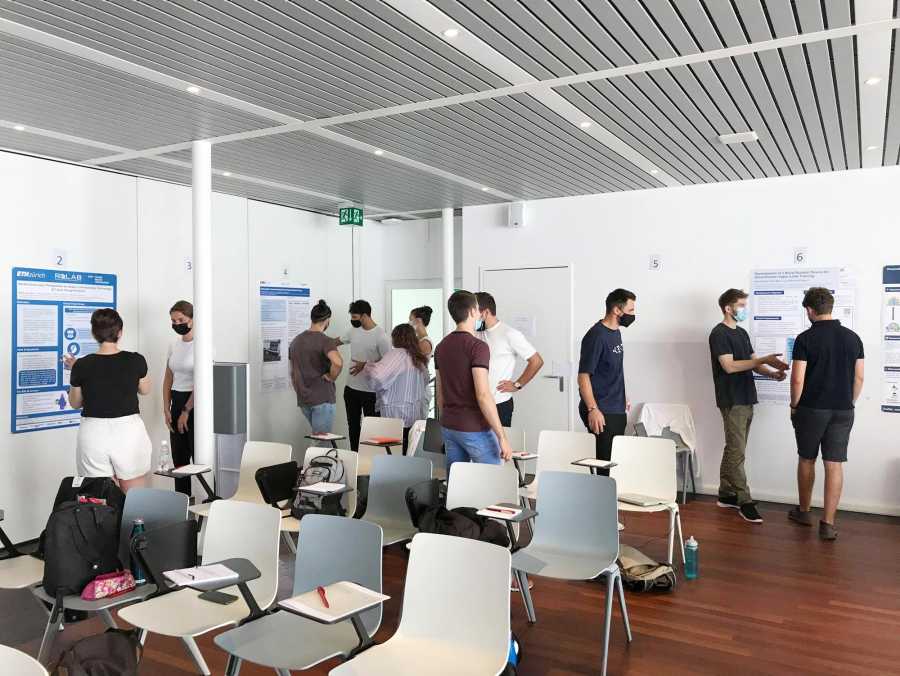Summer School Towards a Continuum of Robot-Assisted Therapy 2021
The topic of this year was the continuum of care from the hospital to patients’ home, with a focus on minimally-supervised technology-assisted therapy.

Abstract
The TCRT Summer School aims to strengthen the collaboration between engineers and clinicians for the development of novel technological tools and therapeutic plans that are able to answer patients’ and clinicians’ needs and improve their quality of life.
Engineers and clinicians need to develop a common language and work side by side from the very early stages of the design of new technological tools all the way to their application in clinical settings. Bridging the technical knowledge with medical knowledge would allow to explore new solutions in technology-assisted rehabilitation.
This Summer School will focus on three topics (T1-T3) related to establishing a technology-assisted continuum of therapy, from the clinic to the home, to promote independence in persons with neurological injuries such as stroke. We will discuss the related challenges and opportunities through plenary lectures and interactive group sessions (case studies) involving participants, clinicians, and patients to bring in different perspectives.
T1. Fundamentals of minimally-supervised therapy
In order to maximise recovery, therapy should be tailored to each patient individually. This can be done by adapting therapy exercises based on the initial level of impairment of the patient and on the performance reached during the different therapy sessions. Such therapy personalization ensures that patients stay motivated throughout the therapy. Robots can provide objective measurements to assess the impairment level of the patient and to monitor improvements throughout the therapy. These features empower continuous adaptation of the difficulty level of the exercises and of the therapy plan, according to the patient’s needs. Assessment-driven therapy is a promising method, which has the potential to truly optimize the current approach to rehabilitation. However, some challenges need to be addressed before this method can be implemented in the clinics, such as the choice of relevant assessments and parameters to ensure a meaningful and efficient adaptation.
T2. Application of minimally-supervised robot-assisted therapy in the clinic
Therapy dose seems to be a limiting factor for patients’ recovery. Some studies suggested that increasing the dose may lead to better recovery. However, due to limited resources, clinics cannot easily implement more intensive therapy plans. Minimally-supervised robot-assisted therapy might be an alternative solution to increase therapy dose without increasing the burden of work for the therapists, since the patients could train with the robots without constant supervision. However, to minimize therapists’ intervention, these devices need to meet several requirements, such as high usability and ability to adapt the therapy plan to the patients. Clinicians and engineers should discuss which functions can be better trained and which type of device should be used during minimally-supervised therapy. Importantly, therapists’ experience should be considered when implementing decision-making algorithms into the robots. Tight collaboration is needed in order to efficiently integrate minimally-supervised robotic therapy into the clinical environment.
T3. Minimally-supervised robot-assisted therapy at home
Robots suitable for home-use need to be developed to strengthen the continuum of therapy after discharge from clinics. Tight collaborations between engineers and clinicians allow the development of appropriate devices maximizing compliance and therapy effectiveness, at the same time taking into account portability and low cost.
In this summer school, experts from different disciplines involved in robot-assisted therapy will be brought together to discuss the recent developments and findings in rehabilitation, interact and exchange views and opinions, with the intent of finding a common understanding and a definition of shared goals. This summer school aims to enhance not only collaborations between engineers and clinicians, but to make them work in synergy. Two thirds of the participants will be students from ETHZ and EPFL, with backgrounds in the different engineering disciplines or health/life sciences. The other third will be selected among national and international applicants based on their background in fields related to rehabilitation. Priority will be given to applicants with a medical or physical therapy background in order to promote knowledge exchange across disciplines. A maximum of 30 students (20 from ETHZ or EPFL, and 10 international) will take part in the summer school.
Program
Confirmed lecturers are:
- Prof. Dr. Silvestro Micera, Translational Neural Engineering Lab, École Polytechnique Fédérale de Lausanne
- Dr. Ilse Lamers, Hasselt University (online)
- Prof. Dr. Joachim Hermsdörfer, Technische Universität München
- Dr. med. Daria Dinacci, Clinica Hildebrand Centro di riabilitazione Brissago
- Prof. Dr. med. Joachim Liepert, Kliniken Schmieder Allensbach (online)
- Dr. Olivier Lambercy, Rehabilitation Engineering Lab, ETH Zurich (online)
- Dr. Gerdienke Prange-Lasonder, Roessingh Research & Development
- Prof. Maura Casadio, University of Genova
- Prof. Dr. David Reinkensmeyer, University of California, Irvine (online)
In the afternoon, students will attend one of five different case studies. In each case study, a patient of the clinic, together with a therapist, will present his/her case and describe a situation where an assistive technology would be helpful. Students will have to work together over the different days and apply what they have learned during the plenary lectures to design an appropriate assistive/rehabilitation/assessment solution to the proposed problem.



